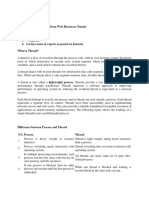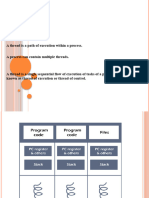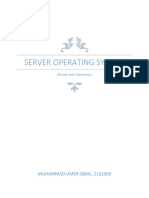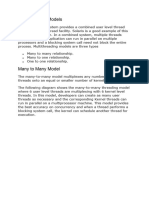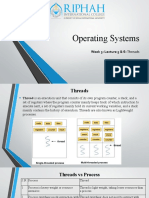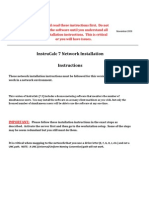0 ratings0% found this document useful (0 votes)
6 viewsThread
Uploaded by
recu12121Copyright
© © All Rights Reserved
Available Formats
Download as PDF, TXT or read online on Scribd
0 ratings0% found this document useful (0 votes)
6 viewsThread
Uploaded by
recu12121Copyright
© © All Rights Reserved
Available Formats
Download as PDF, TXT or read online on Scribd
You are on page 1/ 8
Thread:
Thread is a separate execution path. It is a lightweight process that the
operating system can schedule and run concurrently with other
threads. The operating system creates and manages threads, and they
share the same memory and resources as the program that created
them. This enables multiple threads to collaborate and work efficiently
within a single program.
A thread is a single sequence stream within a process. Threads are
also called lightweight processes as they possess some of the
properties of processes. Each thread belongs to exactly one process.
In an operating system that supports multithreading, the process can
consist of many threads. But threads can be effective only if CPU is
more than 1 otherwise two threads have to context switch for that
single CPU.
Types of threads:
Threads are of two types. These are described below.
User Level Thread
Kernel Level Thread
User Level Threads
User Level Thread is a type of thread that is not created using system
calls. The kernel has no work in the management of user-level threads.
User-level threads can be easily implemented by the user. In case
when user-level threads are single-handed processes, kernel-level
thread manages them. Let’s look at the advantages and disadvantages
of User-Level Thread.
Advantages of User-Level Threads
Implementation of the User-Level Thread is easier than Kernel
Level Thread.
Context Switch Time is less in User Level Thread.
User-Level Thread is more efficient than Kernel-Level Thread.
Because of the presence of only Program Counter, Register Set,
and Stack Space, it has a simple representation.
Disadvantages of User-Level Threads
There is a lack of coordination between Thread and Kernel.
Inc case of a page fault, the whole process can be blocked.
Kernel Level Threads
A kernel Level Thread is a type of thread that can recognize the
Operating system easily. Kernel Level Threads has its own thread
table where it keeps track of the system. The operating System Kernel
helps in managing threads. Kernel Threads have somehow longer
context switching time. Kernel helps in the management of threads.
Advantages of Kernel-Level Threads
It has up-to-date information on all threads.
Applications that block frequency are to be handled by the Kernel-
Level Threads.
Whenever any process requires more time to process, Kernel-Level
Thread provides more time to it.
Disadvantages of Kernel-Level threads
Kernel-Level Thread is slower than User-Level Thread.
Implementation of this type of thread is a little more complex than a
user-level thread.
Multithreading Models:
Some operating system provide a combined user level thread and Kernel
level thread facility. Solaris is a good example of this combined
approach. In a combined system, multiple threads within the same
application can run in parallel on multiple processors and a blocking
system call need not block the entire process. Multithreading models are
three types
Many to many relationship.
Many to one relationship.
One to one relationship.
Many to Many Model
The many-to-many model multiplexes any number of user threads onto
an equal or smaller number of kernel threads.
The following diagram shows the many-to-many threading model where
6 user level threads are multiplexing with 6 kernel level threads. In this
model, developers can create as many user threads as necessary and the
corresponding Kernel threads can run in parallel on a multiprocessor
machine. This model provides the best accuracy on concurrency and
when a thread performs a blocking system call, the kernel can schedule
another thread for execution.
Many to One Model
Many-to-one model maps many user level threads to one Kernel-level
thread. Thread management is done in user space by the thread library.
When thread makes a blocking system call, the entire process will be
blocked. Only one thread can access the Kernel at a time, so multiple
threads are unable to run in parallel on multiprocessors.
If the user-level thread libraries are implemented in the operating system
in such a way that the system does not support them, then the Kernel
threads use the many-to-one relationship modes.
One to One Model
There is one-to-one relationship of user-level thread to the kernel-level
thread. This model provides more concurrency than the many-to-one
model. It also allows another thread to run when a thread makes a
blocking system call. It supports multiple threads to execute in parallel
on microprocessors.
Disadvantage of this model is that creating user thread requires the
corresponding Kernel thread. OS/2, windows NT and windows 2000 use
one to one relationship model.
Difference between User-Level & Kernel-Level
Thread:
S.N. User-Level Threads Kernel-Level Thread
1 User-level threads are faster to create Kernel-level threads are slower
and manage. to create and manage.
2 Implementation is by a thread library at Operating system supports
the user level. creation of Kernel threads.
3 User-level thread is generic and can Kernel-level thread is specific to
run on any operating system. the operating system.
4 Multi-threaded applications cannot take Kernel routines themselves can
advantage of multiprocessing. be multithreaded.
You might also like
- 13 Operating_System_Lec_13_Multi-TthreadingNo ratings yet13 Operating_System_Lec_13_Multi-Tthreading8 pages
- Unit 3 Process and Thread Kernel Data Structure100% (1)Unit 3 Process and Thread Kernel Data Structure3 pages
- Server Operating System: Muhammad Umer Iqbal, 2162069No ratings yetServer Operating System: Muhammad Umer Iqbal, 21620695 pages
- System Software and Operating System 07 - Daily Class NotesNo ratings yetSystem Software and Operating System 07 - Daily Class Notes6 pages
- Chapter-4-Lecture-10-24102024-012811pm (1)No ratings yetChapter-4-Lecture-10-24102024-012811pm (1)20 pages
- Threads: by Salman Memon 2K12/IT/109 University of Sindh JamshoroNo ratings yetThreads: by Salman Memon 2K12/IT/109 University of Sindh Jamshoro16 pages
- Multi Threaded Programming: Heavyweight Process. There Is One Program Counter, and One Sequence ofNo ratings yetMulti Threaded Programming: Heavyweight Process. There Is One Program Counter, and One Sequence of39 pages
- Mastering the Art of Linux Kernel Programming: Unraveling the Secrets of Expert-Level ProgrammingFrom EverandMastering the Art of Linux Kernel Programming: Unraveling the Secrets of Expert-Level ProgrammingNo ratings yet
- Vmware vcpdcv7 3 8 1 Use High Availability To Protect A Vcenter Server ApplianceNo ratings yetVmware vcpdcv7 3 8 1 Use High Availability To Protect A Vcenter Server Appliance3 pages
- 500-381-8 Safe Interface Universal Admin SW (Hotel)No ratings yet500-381-8 Safe Interface Universal Admin SW (Hotel)41 pages
- Purchase Requisition - Released Purchase Orders Monitoring FacilityNo ratings yetPurchase Requisition - Released Purchase Orders Monitoring Facility3 pages
- InstruCalc Network Install InstructionsNo ratings yetInstruCalc Network Install Instructions11 pages
- Zimbra PST Migration Wizard: User's GuideNo ratings yetZimbra PST Migration Wizard: User's Guide6 pages
- Salesforce ADM 201 Study Questions (Ravi Benedetti Guide Via Adam Frank) Flashcards - Quizlet100% (2)Salesforce ADM 201 Study Questions (Ravi Benedetti Guide Via Adam Frank) Flashcards - Quizlet151 pages
- Epson Epson Epson LQ-2190 Epson LQ-2190: Informasi Katalog Komoditas Akun Saya PesanNo ratings yetEpson Epson Epson LQ-2190 Epson LQ-2190: Informasi Katalog Komoditas Akun Saya Pesan1 page
- Origins: Origins of Microsoft Word From Wikipedia CttoNo ratings yetOrigins: Origins of Microsoft Word From Wikipedia Ctto2 pages
- How To Reset P6 R8.3 Password in Sqlite Database: DescriptionNo ratings yetHow To Reset P6 R8.3 Password in Sqlite Database: Description3 pages
- 11 Tips To Improve Windows 10 Performance - TechTargetNo ratings yet11 Tips To Improve Windows 10 Performance - TechTarget10 pages
- ifr6000-and-ifr6015-usb-upgrade-product-information-letter-software-firmware-releases-enNo ratings yetifr6000-and-ifr6015-usb-upgrade-product-information-letter-software-firmware-releases-en3 pages
- Server Operating System: Muhammad Umer Iqbal, 2162069Server Operating System: Muhammad Umer Iqbal, 2162069
- System Software and Operating System 07 - Daily Class NotesSystem Software and Operating System 07 - Daily Class Notes
- Threads: by Salman Memon 2K12/IT/109 University of Sindh JamshoroThreads: by Salman Memon 2K12/IT/109 University of Sindh Jamshoro
- Multi Threaded Programming: Heavyweight Process. There Is One Program Counter, and One Sequence ofMulti Threaded Programming: Heavyweight Process. There Is One Program Counter, and One Sequence of
- Mastering the Art of Linux Kernel Programming: Unraveling the Secrets of Expert-Level ProgrammingFrom EverandMastering the Art of Linux Kernel Programming: Unraveling the Secrets of Expert-Level Programming
- Node.js, JavaScript, API: Interview Questions and AnswersFrom EverandNode.js, JavaScript, API: Interview Questions and Answers
- Vmware vcpdcv7 3 8 1 Use High Availability To Protect A Vcenter Server ApplianceVmware vcpdcv7 3 8 1 Use High Availability To Protect A Vcenter Server Appliance
- 500-381-8 Safe Interface Universal Admin SW (Hotel)500-381-8 Safe Interface Universal Admin SW (Hotel)
- Purchase Requisition - Released Purchase Orders Monitoring FacilityPurchase Requisition - Released Purchase Orders Monitoring Facility
- Salesforce ADM 201 Study Questions (Ravi Benedetti Guide Via Adam Frank) Flashcards - QuizletSalesforce ADM 201 Study Questions (Ravi Benedetti Guide Via Adam Frank) Flashcards - Quizlet
- Epson Epson Epson LQ-2190 Epson LQ-2190: Informasi Katalog Komoditas Akun Saya PesanEpson Epson Epson LQ-2190 Epson LQ-2190: Informasi Katalog Komoditas Akun Saya Pesan
- Origins: Origins of Microsoft Word From Wikipedia CttoOrigins: Origins of Microsoft Word From Wikipedia Ctto
- How To Reset P6 R8.3 Password in Sqlite Database: DescriptionHow To Reset P6 R8.3 Password in Sqlite Database: Description
- 11 Tips To Improve Windows 10 Performance - TechTarget11 Tips To Improve Windows 10 Performance - TechTarget
- ifr6000-and-ifr6015-usb-upgrade-product-information-letter-software-firmware-releases-enifr6000-and-ifr6015-usb-upgrade-product-information-letter-software-firmware-releases-en








